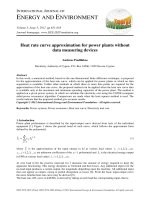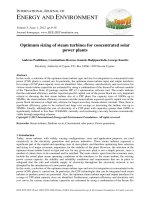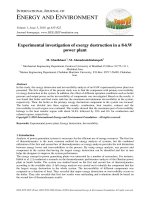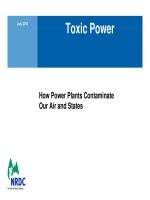home made power plant
Bạn đang xem bản rút gọn của tài liệu. Xem và tải ngay bản đầy đủ của tài liệu tại đây (5.88 MB, 115 trang )
1
HomeMadePowerPlant
Malestrom
2
TABLE OF CONTENTS
Why HomeMadePowerPlant?
……………………………………………………………………5
Chapter 1. Useful tips before starting
What you must now on energy saving…………………………… 7
Chapter 2. Electricity 101
How much do I consume, what is watt, I am no electrician…9
Chapter 3. Your Own Personal Solar Generator
How exactly does it work? …………………………… …….……12
Various types of usage for your solar generators…………22
Parts and tools needed for your energy saving science
project……………………………………………………………………… 37
Step by step guide on how to build your solar personal solar
generator…………………………………………………………………40
Tips on how to lower the cost of your generator ………63
Maintenance Issues……………………………………….……………73
3
Chapter 4. The Power of Wind – The Wind
Generator
How does it work? 75
Why build your own and not buy one? 77
Parts and tools for the wind generator…………………………80
Tips on how to lower the cost of your generator ………81
Step by step guide on how to build your wind powered
generator……881
Chapter 5. So, how much energy do you want?
Some examples of energy consumption and household
appliances……………………………………………………………………98
Chapter 6. Reduce your oil dependence
Methods and suggestions on how you can reduce your oil
consumption…………………………………………………………………100
Chapter 7. The self sustained home of tomorrow,
today
4
Facts, articles and proof………………………………………………101
Chapter 8. Think big
Imagine renewable energy on a larger scale………….……… 104
Chapter 9. Ethanol as an energy source
Energy from sugar and corn………………………………………106
Chapter 10. Hydro-electricity
Find out more about the most widely used form of renewable
energy………………………………………………………………………109
Chapter 11. Why not today
Find out why these easy to make and use devices are not
widely used…………………………………………………………………110
Chapter 12. Future energy
Today’s fantasies, tomorrow’s reality……………………………112
Chapter 13. Frequently Asked Questions
5
FAQ’s……………………………………………………………114
Why HomeMadePowerPlant?
There is one disturbing fact that people are slowly
beginning to realize. We can't depend on fossil fuels for our
energy forever.
Oil prices are skyrocketing around the world. People are
fighting and dying over oil reserves. The damage to our planet
and our climate is irreversible and is becoming more and more
apparent by the day.
Put shortly, chances are that if we don't do something
about our energy situation now, our kids and their kids are
going to have to face some extremely difficult challenges in
the future.
But what can we do? It seems that most alternative
energy choices are too expensive to mass market. As an
individual, is there really anything you can do to make a
difference?
We're going to answer those questions and a whole lot
more throughout this book. We'll look at some of things you
can start doing right now, today, to do your part in solving the
world's energy crisis.
6
Today is the day for change. This is your action plan for
change. In this book you will not find dry, boring
scientific claims that global warming and climate change will
be the end of us all.
In this book you will find interesting and easy to follow
plans to build your own homemade solar panels, find free or
inexpensive solar panels, and find free batteries too. Many
problems plague the modern World right now- whether your
concern is pollution, rising gas and oil prices in the future, or
you fear blackouts and higher energy costs in the future.
The solution to our everyday energy and lifestyle
problems really lies in our own backyard. The actions we take
and the decisions we make everyday can affect change. How
do I know this?
No, I don’t have a fancy science degree from a
famous university, and I don’t support fancy name brand
societies that line their own pockets in the name of marketing
‘Green’ choices.
My family has simply made the choice to implement a
lifestyle that would no longer contribute to global warming
and climate change. The truth is that we have been doing this
for 21 years and we see it working.
That’s the important part in all of this. We all have
to take personal responsibility for our own part in global
warming or there will be no change. Back in the 1960’s when I
grew up I thought we could keep consuming the Earth’s
resources without any consequences.
7
I was wrong.
Chapter 1. Useful tips before starting
What you must now on energy saving
Renewable energy is an amazing thing, but it's not easily
accessible or affordable to everyone in its current state. That
doesn’t mean that there aren’t things that you can do right
now in order to cut down on your energy expenses.
- You can start by using energy efficient fluorescent light bulbs
in all of your lights.
- Turn off all appliances, such as TV’s and computers when
they are not in use. They still consume energy, even in
standby mode.
- Air dry clothes and dishes when at all possible, and only run
the dishwasher or clothes washer with full loads.
- Avoid baths. Try to take short showers.
8
- Keep your thermostat at a comfortable but moderate
temperature. Not too cool in the summer and not too warm in
the winter.
- Drive sensibly and keep your car tuned up for the most fuel
efficiency. Excessive speeding and rapidly accelerating and
breaking can waste gas.
- Make sure that your house is well sealed around windows
and doors. Warm or cool air escaping from homes can
substantially drive up utility costs.
If you plan on using renewable energy such as wind or
solar power in your home then you MUST act on the advice
above.
I didn’t just put it there to look good
.
There is no point going to all the effort of making a wind
or solar generator if you are going to leave lights and power
points on when the appliances are not being used etc.
9
Chapter 2. Electricity 101
For some of you it may be instructional to start at a basic
level in understanding how electricity works in everyday life.
Unless you work everyday in the electronics field or are a
licensed Electrician you may want to get back to the basics
first. Right now we will explain the terms used in this
discussion of electricity as it pertains to your off grid home.
Watts
We started our discussion earlier asking you how many
watts your appliances use everyday and your weekly wattage
(power) consumption.
Most people are fairly familiar with the term
watt
, but
most don’t know what it describes. A
watt
is the power
produced by current (amps) flowing through a wire multiplied
by the pressure (voltage) at which it flows.
Volts
10
Like water pressure in a pipe, voltage is the pressure of
electricity flowing through the wire.
Amps
This is the amount of electricity flowing through the wire.
Power Rates
We are most familiar with the term KWH (or Kilowatt
Hour) as it appears on our monthly power bills. This is the
rate of power flowing through a wire.
As an example, if a 100 watt light bulb is turned on for
ten hours the power rate would be 100 x 10 = 1,000 watt-
hours or 1 Kilowatt hour (kilo means 1000)
Direct Current (DC)
We will be discussing both
Direct Current (DC)
power and
Alternating Current (AC)
in the planning of
your renewable energy system. AC current
is what you presently use in your home.
11
The most important difference between AC and DC
power is that DC current can be stored in a battery while AC
power cannot.
In the Renewable Energy system that you are designing
to run your home DC power produced by your solar panels or
wind generator (for example) will be converted to AC
power by using an inverter. Inverters will be discussed
later in depth.
In this way you can still use many of the same appliances
that you currently depend on. Because of the blessings of
capitalism, AC appliances are cheaper since there are so
many units produced. All you shoppers, I know that I
promised you would be able to buy new appliances, but for
now you should know that you will be able to continue using
some of the appliances you now own.
Common DC voltages are 12, 24 and 48. The advantages
of DC appliances are many, but most important is that DC
motors are more efficient than AC motors. There are many
applications for DC power and the benefit is that we can use
this form of energy in our off grid home, while in your present
tied to the grid home you cannot.
AC Current
12
Alternating current is called this because the current
changes direction constantly. AC is the most common form of
electricity usage today mostly because it is easier to work with
than common DC current.
Chapter 3. Your Own Personal Solar
Generator
How exactly does it work?
Solar power is an amazing thing. The Sun blasts enough
energy over the surface everyday to provide us with more
than enough power to sustain ourselves.
Right now, technological limitations and financial
considerations are the only reasons that we aren’t using solar
power for the majority of our energy needs. That won’t be the
case forever though.
13
Solar power works by collecting the energy output by the
sun over a specified surface area, and then converting that
energy into usable electricity.
Solar panels collect and convert that energy using
photovoltaic cells. The word photovoltaic literally means “light
(photo) “electricity” (voltaic).
What Is PV?
The term "photovoltaic," commonly referred to as PV, is
derived from a combination of the Greek word for light
"photo”, and "Volta," the name of the Italian physicist,
Alessandro Volta, who invented the battery in 1800.
The PV effect is the direct conversion of solar energy into
electricity. This process does not generate much heat like
solar domestic hot water or solar pool heating systems do. It
also differs from the process used in solar thermal, where
concentrated solar energy is used to produce steam that
activates a turbine connected to a generator.
14
PV power systems do not have any moving parts. They
are reliable, require little maintenance and generate no noise
or pollutants. PV systems are great in that they are modular -
the building blocks or cells come in a wide range of power
capabilities, from a fraction of a watt to more that 300 W.
Modules can be connected to achieve the power that your
application requires.
Some large PV power plants have several megawatts of
power, although most installed PV systems are much smaller.
Unfortunately, there is a lot of the sun’s energy lost in
this transfer of energy from light to electricity. Everyday larger
and more efficient panels are manufactured it seems.
15
Even though they are not that efficient at converting light
to electricity solar panels remain a very good choice in the
renewable energy system because of their low maintenance
and long life.
Properly installed your solar panel array should last
around 50 years. Not a bad long term investment for most
people.
The Advantages of PV Power Systems
Users of PV power systems appreciate their quiet, low-
maintenance, pollution-free, safe and reliable operation, as
well as the degree of independence they provide.
Why else should you consider a PV system?
If you are some distance from an electrical grid, it may
be cheaper to generate your own power rather than pay to
extend transmission lines from the grid.
Fossil fuel- Diesel, gasoline or propane generators are
the main alternatives, but many people find them noisy,
polluting and costly to run and maintain.
16
It also makes little sense to turn on a 5-kW generator to
power a few 100-W light bulbs or the TV. PV systems reduce
the negative aspects of generators by using them only as a
backup.
When capital cost is an issue, or when photovoltaics
alone are not enough to replace an existing generator, you
can use a wind generator as part of a hybrid PV system. It
works great and reduces the use of the generator.
This kind of charging system is more efficient than a
generator running continuously at low load.
In addition to saving fuel and lowering maintenance
costs, you will increase the generator's life span.
Also, since the PV panels and battery banks are modular,
you can expand the PV system gradually as your budget or
needs increase. That, we think is the best part.
The Limitations of PV Power Systems
It is important to realize that PV power systems are
expensive when compared with the low price of utility power
in North America for the most part.
17
You should reserve the electric power produced by PV
modules, an inverter and a storage system for your most
energy-efficient appliances, tools, lights, etc.
Although it is technically possible, heating with
photovoltaic is generally not recommended. You can easily
and more efficiently collect heat with a solar thermal system.
A solar water heater or pool heater mentioned earlier
generates more hot water with less initial cost than any PV-
powered heater.
Also, for cooking, it is generally more cost-effective and
convenient to use a stove that operates on propane or
natural gas rather than solar electricity.
Stand alone PV-powered homes and cottages often rely
on wood cook stoves for cooking and space heating.
Refrigerators are becoming more energy efficient, so
the cost of operating them with PV power is now feasible.
They make some great ones now.
What type of Solar Panels should I choose?
A PV System to Suit Your Particular Power
Requirements
Right now you can choose from three main types of
panels:
18
-
Monocrystalline
;
-
Polycrystalline
;
-
ThinFilm
( or Amorphous);
Tried and True Monocrystalline Solar Panels…
For many years monocrystalline solar modules have been
the workhorses of the solar market. Those iridescent blue
faced panels you have been seeing on rooftops are probably
of this type of panels.
For most of you this is the type of solar panels you will
build because these types of cells are readily available.
They have distinct rounded individual solar cells visible
from all angles stacked in very uniform rows.
This type of solar panel is produced from a single silicon
ingot or crystal. Manufacturing costs are very high because of
this process making them the most expensive solar modules
on the market.
They are, however the most efficient type of solar
panel making them the correct choice when space is at a
premium.
Monocrystalline
cells have a life expectancy
far exceeding 25 years, probably over 50 years. The only
real problem with this type of cell is it’s fragile nature making
it a requirement that it be mounted in a very rigid
frame.
Polycrystalline Solar Panels…
19
Polycrystalline
modules are manufactured from a block
of multi-crystalline silicon. They are usually square and have a
varied, almost mosaic-like appearance.
Only slightly less efficient than
monocrystalline
modules they are cheaper to manufacture and thus cost less
money. You can expect the same great lifespan as
monocrystalline
cells too.
Thin Film Solar Panels…
Recently a new product was introduced into the market
that could provide some much needed answers for solar
power users. Amorphous silicon PV or thin film technology
could make rigid solar panels obsolete if some better research
is done.
Thin film solar panels are produced by applying silicon
material on glass or stainless steel, or more commonly
between two pieces of flexible laminate material.
Solid or rigid thin film panels are in use but flexible
laminated thin film panels are more popular. The flexible
panels can be applied to any surface and sometimes used as
roofing material.
Most customers like the almost seamless blending of
solar panels right into their roof top. Saving you the cost of
regular shingles or steel roofing, thin film solar panels are a
good choice.
These panels are not nearly as efficient at converting
light to electricity when compared to mono or polycrystalline
20
solar panels- not nearly by half. You would need twice the
space to accommodate their installation.
From a manufacturing standpoint they do absorb light
more efficiently though, allowing for a thinner design and less
material being used in their manufacture.
The real benefit, because less material is needed, is in
the simplified manufacturing process resulting in lowered
costs to build. The lower price pushed thin film panels to the
lead in price per watt of output.
The panels may have to be slightly larger, but it costs
less for the homeowner for every watt of power production.
They are flexible, light and rarely break during shipping. Add
in the great price and this makes thin film panels a great
choice where space is not a consideration.
They jury is still out on the lifespan of these panels
though. Some say they will last just as long as
monocrystalline panels, others point to their decreased
efficiencies only a couple of years after purchase.
As mentioned earlier, with increased research this could
be the answer. We have a couple smaller panels and they
seem to work fine, but we like our monocrystalline solar
panels and are going to stick with them. Your choice.
21
New Technologies…
There are many new forms of solar panels out there,
from spheral solar to liquid paint on solar panels. All very
revolutionary, but all need some time to be properly tested
before we would recommend them.
From an economic point of view, first consider investing
in energy-efficient electric AC appliances, and then size
your PV system based on actual consumption.
For example, using compact fluorescent lights will reduce
your electrical consumption for lighting by 80 percent or more.
The cells are made up of semi-conductors, with silicon
currently the most widely used.
When the suns rays hit the surface of a semi-conductor,
a reaction takes place. The chemical makeup of the solar
panel absorbs the energy, and the energy causes electrons to
break free of their atoms and in the process they create
electricity.
Advances in semi-conductor technology are allowing for
our solar panels to absorb and retain an increasingly growing
percentage of the energy output by the sun.
22
Various types of usage for your solar
generators
23
Basic diagram of solar power system
24
Did you know that building your own solar generator is not
only easy, but also extremely cost effective?
First off I am going to show you a few different
applications a solar power system can be used with.
The first solar power generator I will talk about will be
my portable system that you can use to power just about
anything you like. This is also a good system that you can
take camping and you can create it for no more then $200. (If
you don’t know what each of the parts are used for please
refer to the end of this chapter.)
Portable Solar Power Generator
This solar generator can literally pay for itself within the
first few weeks that you put it into use.
I have included the most basic setup below but there are
some extra features you can add if you have some money left
over. You can build on this system by using multiple solar
panels and batteries.
We will talk about wiring together multiple panels and
batteries later on in the book.
Please see the below setup diagram:
25
1. Energy source – Solar panel(s) (12V is fine)
2. Charge controller
3. Battery
4. Inverter
5. Household loads (Laptop, TV, DVD player etc.)
This is a really simple solar power setup that you can
create for less then $200. You can either purchase your solar
panel or make your own. We will discuss the process of
building the actual solar panel later on in the book.
This type of system is great for outdoor use. A good
place to store the batteries and other electrical equipment is in
your garage or shed. You can then run appliances straight off
your inverter. Fridges are great to run of this type of system









